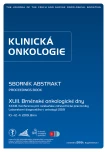Molecular Classification of Medullobastomas by Whole Genome Expression Profiling
Authors:
H. Nosková 1,2; S. Adamcová 2; L. D. Radová Knoflíčková 2 2; Z. Pavelka 1; K. Vejmělková 1; K. Zitterbart 1; O. Slabý 1–3; J. Štěrba 1,4
Authors place of work:
Klinika dětské onkologie LF MU a FN Brno
1; CEITEC – Středoevropský technologický institut, Masarykova univerzita, Brno
2; Klinika komplexní onkologické péče, Masarykův onkologický ústav, Brno
3; Mezinárodní centrum klinického výzkumu, FN u sv. Anny v Brně
4
Published in the journal:
Klin Onkol 2019; 32(Supplementum1): 171-173
Category:
Článek ve sborníku
Summary
Background: Medulloblastoma (MB) is the most common malignant tumour of the central nervous system in children. MB is considered to be high risk tumour propensity to metastasize. In the Czech Republic, approximately 10–12 children are affected annually by this tumour. Recent progress in molecular diagnostics helps to refine the diagnosis and estimate clinical prognosis of the disease. Currently, MBs are subclassified into WNT-activated, SHH-activated, group 3, and 4 based on molecular pathways that drive their tumorigenesis. Each subtype differs in its histopathology, clinical features, genomic changes and gene expressions. The aim of our study is to classify patient’s MBs into four basic molecular groups and compare our results with published data.
Material and methods: In our study we analysed expression profiles using Affymetrix GeneChip Human Gene 1.0. ST Array (Thermo Fisher Scientific, MA, USA). As input material RNA extracted from the fresh frozen tissue was used. Molecular classification based on the method established by P. Northcott in 2011 was performed.
Results: From April 2015 to February 2019, 21 patients with MBs were included in our study. Median age of the patients at the time of diagnosis was 6 years, 14 boys and 7 girls were enrolled. Gene expression profiling and molecular classification of MBs was performed. Based on this methodology, we found the most frequently represented subgroup of MB was group 4 (9 patients, 43%), followed by group 3 (5 patients, 24%), SHH-activated MB (4 patients, 19%) and the least represented subgroup was WNT-activated MB (3 patients, 14%). Results of molecular subgroup classification of MBs were successfully correlated with histopathological findings and other molecular-genetic examinations.
Conclusion: Molecular classification of MBs has been established in our institution allowing better understanding of this heterogeneous disease and helping clinicians in therapeutic planning in affected patients.
This work was supported by the Czech Ministry of Health grant No. 16-33209A.
All rights reserved.
he authors declare they have no potential confl icts of interest concerning drugs, products, or services used in the study.
The Editorial Board declares that the manuscript met the ICMJE recommendation for biomedical papers.
Submitted: 1. 3. 2019
Accepted: 4. 3. 2019
Keywords:
gene expression profiling – precision medicine – Pediatric oncology – Medulloblastoma
Zdroje
1. McKean-Cowdin R, Razavi P, Barrington-Trimis J et al. Trends in childhood brain tumor incidence, 1973–2009. J Neurooncol 2013; 115 (2): 153–160. doi: 10.1007/s11060-013-1212-5.
2. Curran EK, Sainani KL, Le GM et al. Gender affects survival for medulloblastoma only in older children and adults: a study from the Surveillance Epidemiology and End Results Registry. Pediatr Blood Cancer 2009; 52 (1): 60–64. doi: 10.1002/pbc.21832.
3. Herrlinger U, Steinbrecher A, Rieger J et al. Adult medulloblastoma: prognostic factors and response to therapy at diagnosis and at relapse. J Neurol 2005; 252 (3): 291–299. doi: 10.1007/s00415-005-0560-2.
4. Zitterbart K, Pavelka Z, Zitterbartová J. Meduloblastom: nejčastější zhoubný nádor mozku u dětí. Onkologie 2010; 4 (4): 256–259.
5. Northcott PA, Korshunov A, Witt H et al. Medulloblastoma comprises four distinct molecular variants. J Clin Oncol 2011; 29 (11): 1408–1414. doi: 10.1200/JCO.2009.27.4324.
6. Northcott PA, Shih DJ, Remke M et al. Rapid, reliable, and reproducible molecular sub-grouping of clinical medulloblastoma samples. Acta Neuropathol 2012; 123 (4): 615–626. doi: 10.1007/s00401-011-0899-7.
7. Ramaswamy V, Remke M, Bouffet E et al. Risk stratification of childhood medulloblastoma in the molecular era: the current consensus. Acta Neuropathol 2016; 131 (6): 821–831. doi: 10.1007/s00401-016-1569-6.
8. Zhukova N, Ramaswamy V, Remke M et al. Subgroup-specific prognostic implications of TP53 mutation in medulloblastoma. J Clin Oncol 2013; 31 (23): 2927–2935. doi: 10.1200/JCO.2012.48.5052.
9. Cavalli FMG, Remke M, Rampasek L et al. Intertumoral heterogeneity within medulloblastoma subgroups. Cancer Cell 2017; 31 (6): 737–754. doi: 10.1016/j.ccell.2017.05.005.
10. Kool M, Koster J, Bunt J et al. Integrated genomics identifies five medulloblastoma subtypes with distinct genetic profiles, pathway signatures and clinicopathological features. PLoS One 2008; 3 (8): e3088. doi: 10.1371/journal.pone.0003088.
Štítky
Dětská onkologie Chirurgie všeobecná OnkologieČlánek vyšel v časopise
Klinická onkologie

2019 Číslo Supplementum1
- Metamizol jako analgetikum první volby: kdy, pro koho, jak a proč?
- Jak souvisí postcovidový syndrom s poškozením mozku?
- Nejasný stín na plicích – kazuistika
- Cinitaprid – v Česku nová účinná látka nejen pro léčbu dysmotilitní dyspepsie
- Bukálně podávaný fentanyl v léčbě průlomové bolesti u onkologických pacientů
Nejčtenější v tomto čísle
- Metastazující světlobuněčný renální karcinom bez zjevného primárního ložiska v ledvině imitující pokročilé stadium plicní malignity
- Encyklopedie subsetů CLL – unikátní bioinformatický nástroj a databáze pro analýzu subsetů stereotypních B buněčných receptorů u CLL
- Molekulární klasifikace meduloblastomů pomocí celogenomového expresního profilování
- Analýza mikroRNA v krevní plazmě s cílem identifikovat pacienty s duktálním adenokarcinomem pankreatu mající benefit z chirurgické resekce
